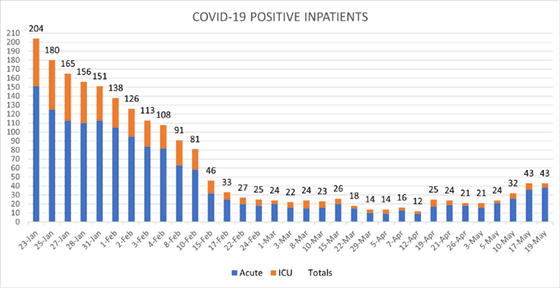Quick Read
- The current surge in King County is resulting in a higher COVID-19 hospital census and also increasing the number of employees who are in isolation or quarantine.
- Employees attending conferences and other large group gatherings should continue to take precautions and have plans for operational continuity if they become ill or have an exposure.
- UW Medicine will begin providing boosters to eligible children ages 5 to 11 following today’s approval by the CDC.
- We are monitoring other pathogens with epidemic potential, such as H5N1 avian influenza (in chicken flocks in western Washington) and monkeypox (reported in Massachusetts).
Picking up on the theme from my last message, we are still figuring out the conditions and contours of this new pandemic planet. We are in a surge of unclear size, but one that is affecting many thousands of people in King County every week. Over 100 people were admitted to hospitals locally in the last week, and our UW Medicine inpatient COVID-19 census continues to rise (see below). For those who, fortunately, do not become sick enough to be hospitalized, getting COVID-19 still brings many challenges, ranging from missed school, work, and other activities to persistent symptoms (“long COVID”). And all of this is happening as many people outside of healthcare have moved on to a post-pandemic world, and we hear different messages depending on the source and day.
A concrete challenge that we are facing right now is the number of staff, students, and faculty who either have COVID-19 or have a high-risk exposure that requires quarantine. It is important again to state that there is no stigma attached to contracting the virus or being exposed. It is part of life and understandable. The challenge for us in healthcare is that there is so much COVID-19 circulating that it is hitting far too many people, making them ill and keeping them home at a time when the amount of patient care needed is unprecedented.
Another consideration for the UW Medicine community is the increasing number of conferences and meetings where healthcare workers may congregate. While these activities are often great opportunities for community building, professional development, and learning, they’re also events that can bring large groups of people together in confined spaces. As we encounter more gatherings like this, I urge you all to play it safe for the health and safety of you and your family, as well as that of your patients and colleagues.
Here are our Infection Prevention & Control recommendations:
- Wear a mask when indoors in public spaces, including lecture halls, during group activities, in airports, and onboard planes or other public transportation.
- Use the highest-level mask available (for example, a KN95 is preferred to a surgical mask).
- When traveling, eat outdoors whenever possible and in small groups.
- Avoid crowded indoor settings.
- Make plans for operational continuity at work if you need to isolate or quarantine after travel.
Looking beyond spring and summer, we are monitoring the potential for challenges that may become more prevalent in the fall. While rapid antigen testing remains a useful tool, the increasingly limited availability of PCR testing could make trend spotting difficult. We will continue to maintain awareness of this situation so we can work to stay a few steps ahead of any surge in infections.
UW Medicine COVID-19 Activity Summary

Local/National/Global Epidemiology
King County: Public Health – Seattle & King County is reporting 416,048 total cases and 2,779 deaths as of Wednesday, May 18. The number of new positive tests over the past seven days is currently at 346.1 per 100,000 people.
Washington: The Department of Health reports 1,544,119 cases and 12,833 deaths as of May 17.
United States: The Centers for Disease Control and Prevention reports 130,838 new cases, 82,677,263 total COVID-19 cases and 997,887 deaths as of May 18.
Global: The WHO COVID-19 Dashboard reports 520,912,257 confirmed COVID-19 cases and 6,272,408 deaths as of May 19.
Boosters for Ages 5-11
With today’s approval from the Centers for Disease Control and Prevention (CDC), UW Medicine will provide a single booster dose of the Pfizer-BioNTech COVID-19 vaccine to all children ages 5 to 11 who have completed their primary, two-dose series at least five months prior.
Appointments will be available at UW Medical Center – Montlake, Harborview Medical Center, and UW Medicine Primary Care clinics. We continue to provide primary series vaccinations to all individuals 5 and older at these locations, as well. Boosters remain a safe and effective way of reducing the risk of serious COVID-19 illness in all age groups, including children. For more information about boosters, visit UW Medicine COVID-19 Updates & Information.
Viruses with Epidemic Potential
Although the current pandemic is new to us, we have lived with viruses with epidemic potential for the whole history of humanity. SARS-CoV-2, the virus that causes COVID-19, is having the biggest impact right now, but we are keeping our eyes on other pathogens that you may be seeing in the media, such as H5N1 avian influenza (in chicken flocks in western Washington) and monkeypox (now with cases being reported in Massachusetts). Neither of these infectious diseases poses anywhere near the threat of COVID-19, but both deserve our attention and appropriate caution.
As we continue to live through this pandemic, we all share the responsibility to remain vigilant in situations that could set us back from all the strides we have made. We all want to move forward, beyond COVID-19, which still requires each of us to play it safe when in doubt. Please remember that we can participate in many activities safely when we take precautions, such as masking in indoor public spaces, getting boosted, and gathering outdoors when possible. The good news? It looks as though spring has finally arrived (70 degrees on Sunday!), right when we can all use a breath of fresh air.
Sincerely,
John Lynch, MD, MPH
Medical Director, Infection Prevention & Control
Associate Medical Director, Harborview Medical Center
Division of Allergy & Infectious Diseases, UW School of Medicine

